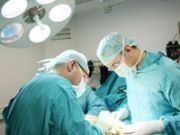Study Finds Radiofrequency Ablation and Laser Ablation Equally Effective and Safe in the Treatment of Thyroid Nodules
Radiofrequency ablation and percutaneous laser ablation are both effective and safe for the management of benign thyroid nodules, with no significant differences in nodule volume reduction between the two techniques.

A team of Italian researchers compared the effectiveness of percutaneous laser ablation (PLA) and radiofrequency ablation (RFA) in the treatment of benign thyroid nodules upon preliminary evaluation. The study team, from the Ospedale Evangelico Internazionale Genova and the University of Genoa, in Genoa, Italy, determined that both radiofrequency ablation and percutaneous laser ablation are “excellent and safe procedures in the management of benign thyroid nodules,” according to the study abstract, with no significant differences in nodule volume reduction between the two techniques. The outcome of this study was presented at the 83rd Annual Meeting of the American Thyroid Association, in San Juan, Puerto Rico, on October 19, 2013.
Benign thyroid nodules are common findings during ultrasound evaluation and clinical examination. Sometimes, they may require treatment for associated symptoms and/or due to cosmetic problems. For those patients who cannot undergo surgery or who refuse it, non-surgical, minimally invasive percutaneous treatments can be used, such as percutaneous laser ablation and radiofrequency ablation.
Radiofrequency ablation uses the heat generated from high-frequency alternating current to ablate tissue. The study team treated the nodules with the “moving shot” technique (moving backwards and upwards with steps until the entire nodule becomes hyperechoic), with a STARmed (Korea) 18G bipolar RF electrode.
Percutaneous laser ablation is the process of removing material from a solid surface by irradiating it with a laser beam (EcholaserX 1,064 μm diode laser unit, [Elesta, Italy]). Tissue is destroyed primarily (to about 80% in extent) by energy absorption.
The study team treated 33 adult patients with benign thyroid nodules: 13 with PLA and 20 with RFA. Prior to treatment, thyroid nodules were examined by ultrasound to evaluate morphologic and intrinsic features, and anatomic relationships with critical surrounding anatomic structures. All nodules (mean volume ± SD: 12.7 ± 6.1 ml) had at least 80% of solid component and were confirmed as not malignant (classified as Thy2) on two consecutive ultrasound-guided fine-needle aspiration. Right after the ablation procedure, a contrast-enhanced ultrasound was performed on treated nodules after one week to identify the area of necrosis. Then, patients were followed-up at one week with ultrasound, one month with contrast-enhanced ultrasound, and at six and 12 months with ultrasound, in order to assess nodule volume reduction and treatment outcomes.
After procedures, patients were clinically evaluated in order to detect voice changes and skin burns, and reevaluated with ultrasound after two hours to exclude any kind of complication. In all cases, a wide area of nodule ablation was safely obtained. There were no procedural complications.
Reduction of nodules treated with RFA ranged 27-53% at one month and 55-84% after 12 months. Reduction of nodules treated with PLA ranged 25-45% at one month and 53-76% after 12 months. Based on these results, the study authors concluded that reduction in nodules' volumes showed no significant differences when comparing the two techniques.
Concluding that both PLA and RFA are effective for managing benign thyroid nodules, the study abstract states that “safety represents the primary treatment prerogative, hence the critical presentation and the radiologist's skills should play an important role in the procedure planning.” Moreover, the study authors suggest that the choice between RFA and PLA could be made on the basis of the nodule's location and its morphologic features, preferring RFA for more superficial and irregular-shaped nodules and PLA for deeper ones.
“We used the moving-shot technique described in the literature to ablate the majority of the nodules. Anyway, the capability of the radiologist to reach the most difficult and outer portions of the nodules allows to improve the percentage of parenchyma ablated, particularly with RFA,” the study team stated at the ATA meeting. “The fact that, usually with PLA, more than one fiber has to be inserted in the neck does not represent an important limitation, but has to be considered, particularly for greater nodules. When performing PLA, it is important to start 1 cm from the bottom of the nodule in order to make the procedure correctly and safely.”